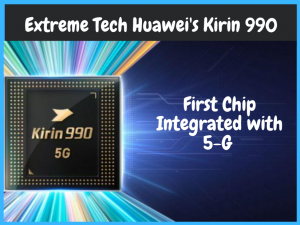Huawei Kirin chipset
What is Huawei Kirin chipset 990 5-G ?
Since 5G networks are still under growth, producers of mobile chipsets prefer to avoid inserting the 5G modem into chipsets. Instead, they elect to get the 5 G modem in conjunction with a 4 G modem within the processor as a separable component. By positioning the huawei kirin chipset as different processes, they can be integrated as needed without needing to produce certain sections of the chipset, thus minimizing costs. The Kirin 990 5 G is indeed an octa-core processor with 10.3 billion transistors, 7 nm long. Its absolute numbers large, two centre and four small cores to maximize multitasking, to 2.86GHz, 2.36GHz, as well as 1.95GHz clock velocities respectively. The 990 5 G even carries a 16-core Mali G76 graphics chipset that will provide more than enough power for mobile gaming and also constructed-in smart caching to minimize latency by up to 15 percent. But Huawei wants to bring to your attention with 5 G and Automation. At the latest press conference in Berlin, corporation representatives told journalists that the Kirin 990 5 G can accomplish downlink speeds of up to 2.3Gbps and up to 1.25Gbps. every new Smartphone has its 5 G phone system processor different from the main chipset of the mobile device; widely known as the SoC (System on a chip). Or to put it another way: the mobile minds that make it work. Only the latest Huawei Mate 20 X 5 G has different handsets from the CPU. However, putting into the same chip will imply improve performance, which would-hopefully-mean 5 G phones normally can’t all be as large since they are today, due to simpler heat dissipation and the reality that the circuit board actually has less chips on it. The Kirin 990-which will control the Mate 30-will also be eligible as a 4 G variant in that regard. That implies the Mate 30 / Mate 30 Pro are available both in 5 G and 4 G designs, with accessibility based on the industry. What’s also fascinating about how it manages 5 G is that it can start making concurrent use of 4 G and 5 G in regions where the 5 G signal may be weaker. Increasing the functionality easily and make it more accessible than you would consider on other devices. As for rates, Huawei reports a theoretical maximum of 2.3Gbps download speed and an average 1.25Gbps upload speed. Although we’re unlikely to actually see these kinds of numbers across our busy, crowded areas in real-life systems, it does imply you ‘re going to get better output than you’d get from your home wired Internet. That’s-of duration-if even the network you ‘re on endorses velocities that are as large. The Snapdragon X55 modem will reach up to 7 Gbps for reference, but Qualcomm’s chip embraces the quicker mm-wave design, while Huawei’s does not. Additionally, Qualcomm has yet to declare an actual 5 G built-in CPU.

Figure 1. Huawei Kirin 990
Huawei Kirin chipset 1000 latest processor.
Huawei Kirin 990 5 G is the latest industry premium processor that is helping Huawei and honor high-end phones. Now that the industry is focused on its replacement and some crucial information has appeared online about the forthcoming mobile processors. The latest release from TSMC (Taiwan Semiconductor Manufacturing Company) investment strategy affirms Huawei ‘s upcoming premier processor is labelled Kirin 1000. It is also demonstrated that TSMC will produce the processor and use its 5 nm process. it has been said that this flagship processor will control the Huawei Mate 40 smartphone series that will be planned to launch in the second quarter of this year. Although the accurate official launch has not yet been known.

Figure 2. Huawei Kirin 1000 latest chipset
Furthermore, it’s also been released that the premier processor next year is named Kirin 1100 but is anticipated to be predicated on 5NM+ new tech, which is an enhanced 5NM edition. There is no surety regarding the launch plans for Huawei HI Silicon Kirin 1100 but should be initiated next year with the Mate 50 series. Rather than the Cortex-A76 cores given in Kirin 990, the Huawei Kirin 1000 will showcase ARM Cortex-A77 cores. The A77 provides an increase in performance of 20 percent, but with the transition to a reduced node scale, the performance improvement will be greater. Last year, the company started the trial production of this chipset. The Chinese giant introduced the Huawei Kirin 985 chipset last week, which is placed between the Kirin 990 flagship and the Kirin 820 mid-range processor and will target devices priced under 3000 Yuan. It comes despite the existing Mali-G77 GPU with an integrated 5 G wireless router. It has a double-core NPU that has been explicitly designed to improve computing power, wireless communications, structural and thermal architecture.
Kirin 990 5-G vs Exynos 990.
Huawei ‘s processor loses support for 108MP+ cameras, top out at just 64MP, however, the Mate 30 collection demonstrates it can manage just fine configurations for the quad-camera. It also features out for the streaming video at 4K/60fps, trying to make this the only chipset lacking 8K/30fps endorse here. One benefit the Kirin 990 has is assistance for the low noise new tech of BM3D (block contrasting and 3D tracking), allegedly correlated with DSLR cameras. Huawei says this innovation actually brings away quickly noise for photographs by 30 percent and video by 20 percent. Overall, it seems like Qualcomm and Samsung will gain a megapixel benefit over Huawei’s chipset and video aspect ratio/screen resolution. But Huawei appears to be concentrating more and more on enhancing the low-light performance. Huawei also didn’t stand still, providing two large NPUs and a tiny NPU in the Kirin 990 5 G (and one per day in the 4 G variant). Huawei cites a 1.88x boost over the architecture of the Kirin 980 NPU, and a 24x increase to energy efficiency for activities such as face unlock. Huawei doesn’t seem to have revealed TOPS efficiency for the Kirin 990, however, the third-party AI baseline site mentions it at the second position (behind MediaTek Dimension 1000), with a scoring system of 52,403. For what it’s worth, the fifth Snapdragon 855 Plus got a score of 24,652.
Read for more info